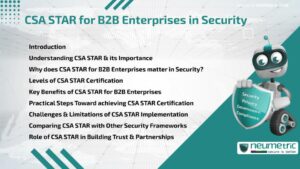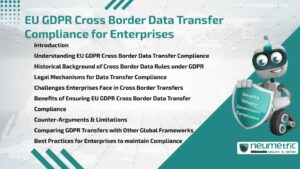Table of Contents
ToggleIntroduction
The SOC 2 Risk Assessment is an essential part of ensuring that Organisations safeguard Customer Data & maintain Compliance with Trust Service Criteria. By systematically identifying Risks, evaluating their impact & implementing effective Controls, businesses can strengthen their Security posture & build Confidence with Clients. For B2B Organisations, the SOC 2 Risk Assessment is not only a Compliance requirement but also a strategic exercise to reduce Vulnerabilities & enhance Operational Resilience. This article explores its definition, importance, steps, common Risks, benefits & practical guidance for decision makers.
What is a SOC 2 Risk Assessment?
A SOC 2 Risk Assessment is a structured process where Organisations evaluate Potential Threats that could impact Security, Availability, Processing Integrity, Confidentiality or Privacy. It involves identifying Vulnerabilities, assessing their Likelihood & Impact & aligning controls with SOC 2 requirements.
Unlike a one-time checklist, this Assessment is an ongoing activity that keeps security practices aligned with evolving Threats & Audit expectations. It serves as the foundation for a successful SOC 2 Audit by showing that Risks are understood & managed proactively.
Why is a SOC 2 Risk Assessment Important for B2B Organisations?
In the B2B world, Client Trust is everything. A SOC 2 Risk Assessment demonstrates that an organisation not only meets Compliance standards but also takes Data Protection seriously. This assurance can be decisive in securing contracts & maintaining long-term partnerships.
Additionally, Regulators, Investors & Industry Partners often expect Risk Assessments as part of Governance. By completing this process, organisations reduce exposure to Data Breaches, Service Outages & Reputational harm.
Key Steps in a SOC 2 Risk Assessment
The SOC 2 Risk Assessment generally includes the following steps:
- Identify Risks: Pinpoint internal & external Threats to Systems & Data.
- Analyse Impact: Determine the potential effect of each Risk on operations.
- Evaluate Likelihood: Estimate how probable each Risk is to occur.
- prioritise Risks: Rank Risks based on severity & business impact.
- Implement Controls: Apply technical, operational & administrative safeguards.
- Monitor & Review: Continuously update the Assessment as new Threats emerge.
This structured method ensures that Risk Management efforts remain focused & effective.
Common Risks Identified in a SOC 2 Risk Assessment
Organisations frequently uncover the following Risks during a SOC 2 Risk Assessment:
- Unauthorised access due to weak Authentication.
- Insider Threats caused by lack of Role-based Controls.
- System downtime from poor redundancy or backup planning.
- Data leakage from insufficient Encryption.
- Vendor-related Risks from inadequate Third Party oversight.
Recognising these Risks early helps Organisations address them before they escalate into Security Incidents.
Benefits of Conducting a SOC 2 Risk Assessment
Performing a SOC 2 Risk Assessment provides tangible benefits:
- Strengthens overall Security Posture.
- Improves Audit readiness & reduces surprises.
- Enhances Client Trust & Competitive positioning.
- Identifies Gaps for proactive Remediation.
- Encourages a culture of continuous Risk Management.
How to Prepare for a SOC 2 Risk Assessment?
Preparation begins with Leadership support. Decision makers should ensure that Risk Assessment is a shared responsibility across business & technical teams. Gathering documentation, defining the scope of systems & reviewing previous Incidents provide valuable input for the process.
Engaging external experts can help Organisations achieve objectivity & apply industry Best Practices, especially when internal resources are limited.
Limitations of a SOC 2 Risk Assessment
While critical, a SOC 2 Risk Assessment has limitations. It cannot eliminate Risks entirely but only manage them to acceptable levels. The results also depend on the quality of data & assumptions used. Moreover, Risks evolve constantly, so Assessments must be revisited periodically to remain relevant.
Practical Tips for Strengthening Security Posture
- Treat Risk Assessment as a continuous process, not a one-time event.
- Use standardised frameworks to guide analysis.
- Involve cross-functional teams for broader insight.
- Prioritise remediation efforts by business impact, not just technical severity.
- Leverage automation tools for monitoring & reporting.
Takeaways
- Identifies & prioritises Security Risks.
- Strengthens Compliance & Audit readiness.
- Builds Trust in B2B relationships.
- Requires Continuous Monitoring & updates.
- Supports a proactive Security Culture.
FAQ
What is the purpose of a SOC 2 Risk Assessment?
It identifies, evaluates & mitigates Risks that affect Compliance with SOC 2 Trust Service Criteria.
Who should be involved in a SOC 2 Risk Assessment?
Both technical teams & business leaders should participate to ensure comprehensive coverage.
How often should a SOC 2 Risk Assessment be performed?
At least annually & more frequently if major system changes or incidents occur.
Does a SOC 2 Risk Assessment replace the Audit?
No, it is a preparatory step that supports the Audit but does not replace it.
What tools are used in a SOC 2 Risk Assessment?
Organisations often use Risk Management software, Monitoring Tools & Compliance frameworks.
Is a SOC 2 Risk Assessment mandatory?
While not legally required, it is strongly recommended for any organisation preparing for SOC 2 Compliance.
What Risks are most commonly identified?
Weak Access Controls, Vendor Risks, insufficient Encryption & lack of Monitoring are frequently noted.
Need help for Security, Privacy, Governance & VAPT?
Neumetric provides organisations the necessary help to achieve their Cybersecurity, Compliance, Governance, Privacy, Certifications & Pentesting needs.
Organisations & Businesses, specifically those which provide SaaS & AI Solutions in the Fintech, BFSI & other regulated sectors, usually need a Cybersecurity Partner for meeting & maintaining the ongoing Security & Privacy needs & requirements of their Enterprise Clients & Privacy conscious Customers.
SOC 2, ISO 27001, ISO 42001, NIST, HIPAA, HECVAT, EU GDPR are some of the Frameworks that are served by Fusion – a SaaS, multimodular, multitenant, centralised, automated, Cybersecurity & Compliance Management system.
Neumetric also provides Expert Services for technical security which covers VAPT for Web Applications, APIs, iOS & Android Mobile Apps, Security Testing for AWS & other Cloud Environments & Cloud Infrastructure & other similar scopes.
Reach out to us by Email or filling out the Contact Form…





